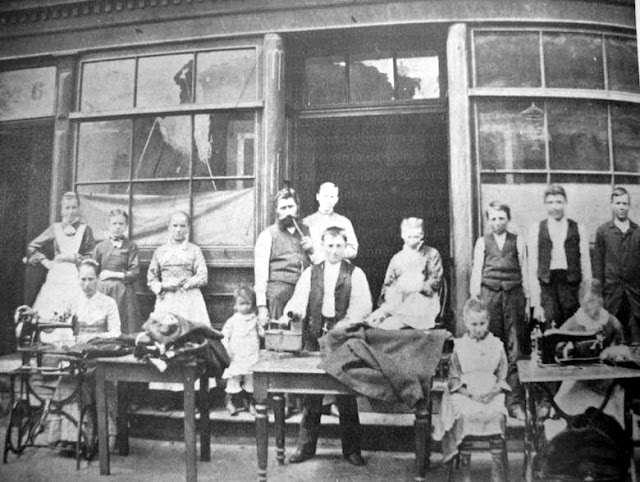Later: Little Sicily "Little Hell" Neighborhood.
Later Still: Cabrini-Green Neighborhood.
Chicago's first Swedish settlement emerged in 1846, when immigrants destined for the Swedish religious colony in Bishop Hill, Illinois, decided instead to settle in Chicago. The boundaries indicated for the oldest Swedish district seem very narrow. The examination of the census lists and city directories indicates that nearly all of the 27 Swedish families which, in the summer of 1850 when the census was made, had their homes in the 7th ward on the city's north side, lived within an area near the river bounded by Erie street on the north and Franklin street ("the east part of the river branch") on the east.
 |
| Chicago Swedish Family |
Swedish settlers in the river area were given notice of eviction by the real estate owners in 1853 or 1854. It has not been verified, but it seems credible in view of the industrial and commercial development of Chicago at that time. The areas along the river banks became quite important because of the city's growing industries, particularly after the opening of the Illinois-Michigan Canal, and of the first railroad, Galena-Chicago Union, in 1848.
Many of these earliest settlers came to work on the Illinois & Michigan Canal. Although the Swedish settlement remained small for the next two decades, reaching 816 people in 1860 and 6,154 in 1870, it represented the largest single cluster of Swedes in the United States. During the 1870s, the Swedish population in the city doubled, outnumbered only by the German, Irish, and British immigrant groups.
As the Swedish settlement moved, the area north of the Chicago River on the Near North Side became known as "Swede Town." It was bounded by La Salle Street on the east, Division Street on the North, Chicago Avenue on the South, and the Chicago River to the west. A second, smaller Swedish area developed on the South Side in Douglas and Armour Square. The third grew on the West Side in North Lawndale. Smaller settlements also emerged in West Town and the Near West Side.
Swedes began leaving "Swede Town" after the devastation of the Great Chicago Fire of 1871. The process accelerated in the 1880s as more and more folks left these initial neighborhoods of settlement for less dense surroundings as the community became increasingly prosperous and worked its way up to Chicago's economic ladder. By 1920 Swedes dominated North Side neighborhoods such as Andersonville (also sometimes referred to as "Swede Town"), Lakeview as well as areas such as Grand Crossing and Englewood to the south. The nickname would reemerge in these new Swedish-dominated districts as the original "Swede Town" became Little Sicily also known as "Little Hell" and later still the Cabrini-Green Neighborhood.
Compiled by Neil Gale, Ph.D.
Earlier: Swede Town Neighborhood.
Later: Cabrini-Green Neighborhood.
The name “Little Hell” was derived from the large gas house that was located at Crosby and Hobbie streets, whose nighttime flames lit the skies at night. The roaring thunder of the furnaces could be heard for blocks as coal was poured into the ovens and moistened with water from the Chicago River to create gas that was used for heating, cooking and lighting. Enormous tanks stored the gas during the day.
The Little Hell neighborhood on the North Side of Chicago was bounded by La Salle Street on the east, Division Street on the North, Chicago Avenue on the South and the Chicago River to the west. Between the 1880s and 1930, Chicagoans referred to the heart of the Little Hell slum as “Death Corner,” a wholly understandable moniker given that the intersection of West Oak Street and Milton Avenue (Milton Avenue changed names to Cleveland Avenue in 1909) was the scene of well over 100 unsolved murders.
The North Side's first great gangster, Dion O'Banion, was a product of this district. Since most of the vice districts in Chicago were on the South and West sides of the city, this area was more or less ignored for many years in the city's fight against crime. It is said that, in the first 51 days of 1906, the police made over 900 arrests.
For two decades, Chicago police remained “hampered at every turn by the silence of the Italian colony” — a reference to the large Italian-American population in the neighborhood.
Typically, as one newspaper story put it, victims would be “murdered before an audience that vanished with the last pistol flash, much as a loon dives beneath the sheltering water just at the moment the hunter’s gun spits out its flame and shot.” Death Corner, as the district’s “central gathering place,” had gained the “international reputation of being the site of more murders than any other territory of equal area in the world.”

By the early 1920s, murders in Little Hell continued at the rate of more than 30 per year — more than one-third of the city’s total, although Italians made up only five percent of the population. By this point, many Death Corner victims were casualties of the Prohibition-era “alcohol rivalries” between the bootlegging gangs of Giuseppe “Joe” Aiello and the infamous Al Capone “Scarface,” leader of Chicago’s most powerful mob. As notorious as Cabrini-Green would become, the violence of Little Hell may well have been worse.
Compiled by Dr. Neil Gale, Ph.D.




